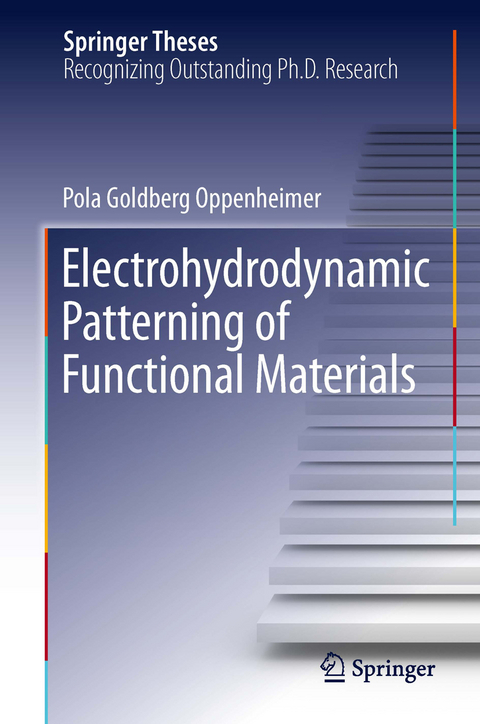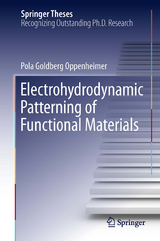Electrohydrodynamic Patterning of Functional Materials
Seiten
2013
|
2013
Springer International Publishing (Verlag)
978-3-319-00782-3 (ISBN)
Springer International Publishing (Verlag)
978-3-319-00782-3 (ISBN)
This book provides a detailed introduction to electrohydrodynamic lithography and its principles. It describes a novel and unique lithographic method of inducing and exploiting surface instabilities.
This thesis explores a route to induce and control the structure formation process in thin films by the use of strong electric fields. We investigate, establish and apply the use of the electrohydrodynamic (EHD) lithography as a versatile patterning tool on the sub-micrometre and nanometre length scales for functional materials. Thin films are ubiquitous, they are found in nature and used in almost every aspect of daily life. While film instabilities are often undesirable in nature and technology, they can be utilized to produce structures by precisely controlling the destabilization of the film. EHD lithography utilizes instabilities induced by means of an electric field to fabricate periodic structures. EHD patterning is set to become a competitive candidate for low-cost lithographic technology for a number of applications. Herein, the applied potential of this lithographic process is explored by expanding its applicability to a broad range of materials and by a simultaneous patterning of multilayer systems or functional polymers yielding hierarchical architectures with novel functionalities.
EHD pattern formation enables for instance, the fabrication of multi-scale structured arrays as surface enhanced Raman scattering (SERS)-active platforms. Furthermore, crystalline and conductive polymers are patterned using the EHD approach and the underlying structure formation mechanisms are discussed. This extension towards functional material systems offers interesting prospects for potential applications. Findings of this thesis are very promising for use in optoelectronic devices.
This thesis explores a route to induce and control the structure formation process in thin films by the use of strong electric fields. We investigate, establish and apply the use of the electrohydrodynamic (EHD) lithography as a versatile patterning tool on the sub-micrometre and nanometre length scales for functional materials. Thin films are ubiquitous, they are found in nature and used in almost every aspect of daily life. While film instabilities are often undesirable in nature and technology, they can be utilized to produce structures by precisely controlling the destabilization of the film. EHD lithography utilizes instabilities induced by means of an electric field to fabricate periodic structures. EHD patterning is set to become a competitive candidate for low-cost lithographic technology for a number of applications. Herein, the applied potential of this lithographic process is explored by expanding its applicability to a broad range of materials and by a simultaneous patterning of multilayer systems or functional polymers yielding hierarchical architectures with novel functionalities.
EHD pattern formation enables for instance, the fabrication of multi-scale structured arrays as surface enhanced Raman scattering (SERS)-active platforms. Furthermore, crystalline and conductive polymers are patterned using the EHD approach and the underlying structure formation mechanisms are discussed. This extension towards functional material systems offers interesting prospects for potential applications. Findings of this thesis are very promising for use in optoelectronic devices.
Theoretical Background and Physical Principles of EHD Instabilities.- Experimental Tools and Analytical Techniques.- Rapid Patterning of Low-Viscosity Resists Using Electrohydrodynamic Lithography.- Alignment of Carbon Nanotubes via EHD-Driven Patterning of Nanocomposites.- Hierarchical EHD Structures for Surface-Enhanced Raman Scattering.- Patterning of Crystalline Organic Materials via EHL.- Electrohydrodynamic Lithography of a Conducting Polymer.- Structural Hierarchy of Functional Block Copolymer System Induced by Electrohydrodynamic Lithography.
| Erscheint lt. Verlag | 7.8.2013 |
|---|---|
| Reihe/Serie | Springer Theses |
| Zusatzinfo | XVIII, 137 p. 47 illus., 39 illus. in color. |
| Verlagsort | Cham |
| Sprache | englisch |
| Maße | 155 x 235 mm |
| Gewicht | 403 g |
| Themenwelt | Technik ► Maschinenbau |
| Schlagworte | 3D Functional Polymers Architectures • Anisotropic Alignment, SERS • Designed 3D Hierarchical Structures • EHD Pattern Formation • Electrohydrodynamic (EHD) Patterning • Patterned Anisotropic Crystalline Polymers • Patterning of Multilayer Systems • Rapid EHD Lithography • Thin Film Instabilities |
| ISBN-10 | 3-319-00782-3 / 3319007823 |
| ISBN-13 | 978-3-319-00782-3 / 9783319007823 |
| Zustand | Neuware |
| Haben Sie eine Frage zum Produkt? |
Mehr entdecken
aus dem Bereich
aus dem Bereich
Normung, Berechnung, Gestaltung
Buch | Softcover (2023)
Springer Vieweg (Verlag)
39,99 €
Buch | Softcover (2023)
Springer Vieweg (Verlag)
24,99 €
Buch | Softcover (2023)
Springer Vieweg (Verlag)
24,99 €




